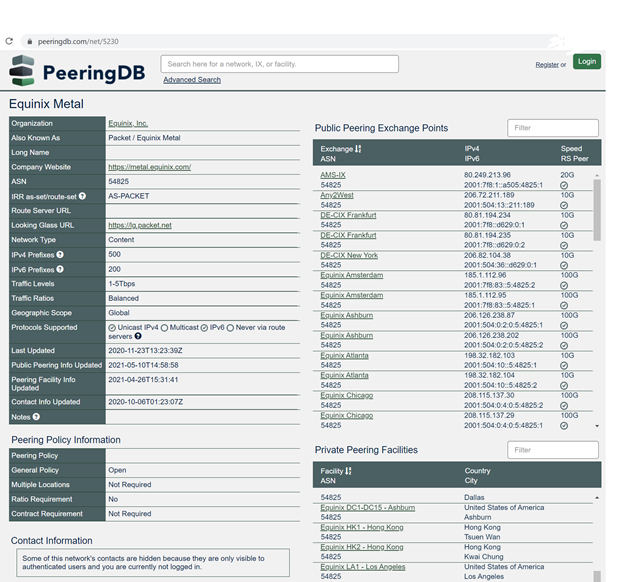Inside Our Network: Peering
Years ago, Adam Rothschild published a blog post about “why we peer” at what was then Packet. Since then, peering has become a critical part of our operations at Equinix Metal. Here’s how it works and where we are going.

Back in 2015, Adam Rothschild published a blog post about “why we peer.” At the time, Packet was a startup operating a growing bare metal cloud network on the public Autonomous System (AS) 54825. In the years to follow, the Packet network and user base has grown significantly.
Packet was acquired by Equinix in early 2020 and rebranded as Equinix Metal. Since then, AS-PACKET has flourished and Metal expanded with deployments in 18+ Equinix metro locations around the world. Despite the rapid growth, one thing that has remained constant is our focus on optimizing our global network.
Peering remains an essential part of this equation. Equinix Metal uses peering paths to continuously tune and optimize routing for our customers. Let’s take a look at how it all works!
So what is peering?
Peering is an arrangement to connect separate autonomous network systems. Arrangements can be private or public, and Equinix Metal participates in both.
Peering reduces the physical distance data has to travel by setting up connections between origin and destination. These checkpoints reduce latency and optimize traffic—similar to a highway system (well, some highways at least).
Private peering requires direct cabling and connection between the devices of two autonomous systems. With private peering, there is guaranteed capacity with more reliability and security than public peering, but is only cost-effective for large volumes of traffic.
Public peering is a lot more common because it uses internet peering exchanges that mutually connect the parties on a shared network fabric. Cabling only needs to be connected at the time the organization joins the Exchange.
From there, the Internet Exchange fabric enables tenants to share traffic with each other at will. The Exchange operators also typically provide route servers to further ease the sharing of traffic.
Ready to drill down?
Choose your own adventure
One thing every organization must consider when joining Internet Exchanges is what type of peering policy makes the most sense for their use case. The main categories of peering policy are open, selective, and restrictive.
An open policy indicates that the organization will typically peer with any other requesting party. Open policies are the most cost-effective, but can also become a bit of a management headache as the number of peers grows.
Some organizations choose to use a selective policy to have more control over the networks with which they peer. Depending on the exchange, the selective peering criteria should be defined in their published peering policy. These criteria can cover minimum traffic exchanged, number of peering points, and more depending on the policy.
Finally, a restrictive policy indicates that the organization does not desire to participate in peering. In this case, peering would be the exception and not the norm.
As a cloud provider, Equinix Metal uses an open peering policy to give us the broadest scope for optimizing traffic. While we think our entire peering policy is important, here is the specific section that covers essential qualifying criteria:
In order to offer more connectivity quality and performance, Equinix Metal operates an international network (AS54825) and welcomes the opportunity to engage in peering with responsible BGP speakers that meet our minimum requirements and are present at mutual Internet Exchanges or data-center facilities.
So, how can you find out all the details about Equinix Metal peering locations and capacities? I am glad you asked! Let’s take a granular look into how our database works.
Behind the curtain
PeeringDB is an online database where public AS network operators maintain their public peering information. Users can search by Autonomous System Number (ASN), Internet Exchange, or location to find peering information. Equinix Metal, for instance, can be found as ASN 54825 under the Equinix Inc organization or by simply using the “54825” in the search bar.

Users can leverage this database to browse through all sorts of information related to the Equinix Metal network. Browse or search through the locations and bandwidth capacities of all of our Public Peering Exchange Points and see that Equinix Metal participates in some form of peering in every deployment.

Naturally, we join Equinix Internet Exchange (EIX) on all Metal deployments and we do so with 100G ports! We also join various third party Exchanges in select markets in order to meet the optimal routing requirements.
While Equinix Metal does participate in private peering, it is mostly reserved for high-capacity interconnect to autonomous systems where we have large, established traffic patterns. The list of facilities where Equinix Metal can connect with peers privately is also documented on our PeeringDB page.
Peer into the future
As you can see, a lot of effort goes into joining the Exchanges, but this is just the beginning. In order to maintain a market-leading experience, our network teams (lovingly known at NetOps internally) continuously analyze traffic, pursue direct peering sessions, and optimize traffic to ensure we give our customers the best possible connectivity.
Another great source of optimization is customer interaction. Since we’re growing fast, adding new metros and building out our network on a monthly basis, Metal customers often have excellent feedback that helps us to improve performance.
If you’d like to learn more about our network, or the role of peering in our strategy, please reach out via our community Slack channel or drop us a note via live chat. We’d love to hear from you.